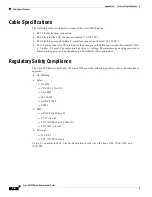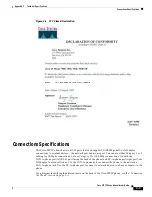
B-60
Cisco SIP IP Phone Administrator Guide
Appendix B SIP Call Flows
Call Flow Scenarios for Failed Calls
Call from a Cisco SIP IP Phone to a Cisco SIP IP Phone via Emergency Proxy
Figure B-23
illustrates a successful call from a Cisco SIP IP phone to a Cisco SIP IP phone via emergency
proxy. User B is the extension of the dial template with the “Route” attribute as “emergency” in the
dialplan.xml file.
6.
180 Ringing—Gateway to
Cisco SIP IP phone (User A)
The gateway sends a SIP 180 Ringing response to User A. The 180 Ringing
response indicates that the gateway is being alerted.
7.
Connect—PBX to gateway
PBX sends a Connect message to gateway. The Connect message notifies the
gateway that the connection has been made.
8.
200 OK—Gateway to Cisco SIP
IP phone (User A)
Gateway sends a SIP 200 OK response to the User A. The 200 OK response
notifies User A that the connection has been made.
9.
ACK—Cisco SIP IP phone
(User A) to gateway
User A sends a SIP ACK to the gateway. The ACK confirms that User A has
received the 200 OK response. The call session is now active.
10.
Connect ACK—Gateway to
PBX
Gateway acknowledges PBX’s Connect message.
11.
BYE—Cisco SIP IP phone
(User A) to gateway
User A terminates the call session and sends a SIP BYE request to gateway. The
BYE request indicates that User A wants to release the call.
12.
Disconnect—Gateway to PBX
Gateway sends a Disconnect message to PBX.
13.
Release—PBX to gateway
PBX sends a Release message to the gateway.
14.
200 OK—Gateway to Cisco SIP
IP phone (User A)
Gateway sends a SIP 200 OK response to User A. The 200 OK response notifies
User A that the gateway has received the BYE request.
15.
Release Complete—Gateway to
PBX
Gateway sends a Release Complete message to the PBX and the call session is
terminated.
Step
Action
Description
















































